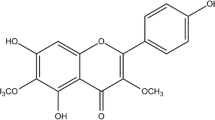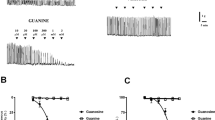Abstract
The effects of honokiol and magnolol extracted from the Magnolia officinalis on muscular contractile responses and intracellular Ca2+ mobilization were investigated in the non-pregnant rat uterus. Honokiol and magnolol (1–100 μmol/l) were observed to inhibit spontaneous and uterotonic agonists (carbachol, PGF2α, and oxytocin)-, high K+-, and Ca2+ channel activator (Bay K 8644)-induced uterine contractions in a concentration-dependent manner. The inhibition rate of honokiol on spontaneous contractions appeared to be slower than that of magnolol-induced response. The time periods that were required for honokiol and magnolol, at 100 μmol/l, to abolish 50% spontaneous contractions were approximately 6 min. Furthermore, honokiol and magnolol at 10 μmol/l also blocked the Ca2+-dependent oscillatory contractions. Consistently, the increases in intracellular Ca2+ concentrations ([Ca2+]i) induced by PGF2α and high K+ were suppressed by both honokiol and magnolol at 10 μmol/l. After washout of these treatments, the rise in [Ca2+]i induced by PGF2α and high K+ was still partially abolished. In conclusion, the inhibitory effects of honokiol and magnolol on uterine contraction may be mediated by blockade of external Ca2+ influx, leading to a decrease in [Ca2+]i. Honokiol and magnolol may be considered as putative Ca2+ channel blockers and be of potential value in the treatment of gynecological dysfunctions associated with uterine muscular spasm and dysmenorrhea.





Similar content being viewed by others
References
Akerlund M (1979) Pathophysiology of dysmenorrhea. Acta Obstet Gynecol Scand Suppl 87:27–32
Anwer K, Oberti C, Perez GJ, Perez-Reyes N, McDougall JK, Monga M, Sanborn BM, Stefani E, Toro L (1993) Calcium-activated K+ channels as modulators of human myometrial contractile activity. Am J Physiol 265:C976–985
Caughey AB, Parer JT (2001) Tocolysis with beta-adrenergic receptor agonists. Semin Perinatol 25:248–255
Chan P, Cheng JT, Tsao CW, Niu CS, Hong CY (1996) The in vitro antioxidant activity of trilinolein and other lipid-related natural substances as measured by enhanced chemiluminescence. Life Sci 59:2067–2073
Chen QS (1986) Pharmacology and applications of Chinese materia media. In: Chang HM, But PPH (eds) World Scientific, Singapore, vol 2, pp 878–880
Foster RW, Small RC, Weston AH (1983) The spasmogenic action of potassium chloride in guinea-pig trachealis. Br J Pharmacol 80:553–559
Fuchs AR (1995) Plasma membrane receptors regulating myometrial contractility and their hormonal modulation. Semin Perinatol 19:15–30
Fujita M, Itokawa H, Sashida Y (1973) Studies on the components of Magnolia obovata Thunb. 3. Occurrence of magnolol and honokiol in M. obovata and other allied plants. Yakugaku Zasshi 93:429–434
Hamasaki Y, Kobayashi I, Zaitu M, Tsuji K, Kita M, Hayasaki R, Muro E, Yamamoto S, Matsuo M, Ichimaru T, Miyazaki S (1999) Magnolol inhibits leukotriene synthesis in rat basophilic leukemia-2H3 cells. Planta Med 65:222–226
Haraguchi H, Ishikawa H, Shirataki N, Fukuda A (1997) Antiperoxidative activity of neolignans from Magnolia obovata. J Pharm Pharmacol 49:209–212
Ivorra MD, Chulia S, Noguera MA, D'Ocon MP (1994) Intervention of two voltage-dependent calcium-entry pathways in the contractile response to acetylcholine and KCl in rat uterus. Pharmacology 49:33–41
Kawarabayashi T, Shojo H, Tsukamoto T (1997) Effects of oxytocin, prostaglandin F2 alpha and prostaglandin E2 on intracellular free calcium concentrations of longitudinal muscle cells isolated from term pregnant rat myometrium. Gynecol Obstet Invest 43:145–149
Kimura M, Kimura I, Maekawa M (1978) The mode of action of contractile effects induced by external calcium and its related bivalent cations in the KCl-depolarized rat uterus. Jpn J Pharmacol 28:681–692
Ko CH, Chen HH, Lin YR, Chan MH (2003) Inhibition of smooth muscle contraction by magnolol and honokiol in porcine trachea. Planta Med 69:532–536
Kuribara H, Kishi E, Hattori N, Okada M, Maruyama Y (2000) The anxiolytic effect of two oriental herbal drugs in Japan attributed to honokiol from magnolia bark. J Pharm Pharmacol 52:1425–1429
Ruttner Z, Ivanics T, Slaaf DW, Reneman RS, Toth A, Ligeti L (2002) In vivo monitoring of intracellular free calcium changes during uterine activation by prostaglandin f(2alpha) and oxytocin. J Soc Gynecol Investig 9:294–298
Tachikawa E, Takahashi M, Kashimoto T (2000) Effects of extract and ingredients isolated from Magnolia obovata thunberg on catecholamine secretion from bovine adrenal chromaffin cells. Biochem Pharmacol 60:433–440
Teng CM, Chen CC, Ko FN, Lee LG, Huang TF, Chen YP, Hsu HY (1988) Two antiplatelet agents from Magnolia officinalis. Thromb Res 50: 757–765
Teng CM, Yu SM, Chen CC, Huang YL, Huang TF (1990) EDRF-release and Ca2+-channel blockade by magnolol, an antiplatelet agent isolated from Chinese herb Magnolia officinalis, in rat thoracic aorta. Life Sci 47:1153–1161
Tsai TH, Lee TF, Chen CF, Wang LC (1995) Modulatory effects of magnolol on potassium-stimulated 5-hydroxytryptamine release from rat cortical and hippocampal slices. Neurosci Lett 186:49–52
Tsatsaris V, Papatsonis D, Goffinet F, Dekker G, Carbonne B (2001) Tocolysis with nifedipine or beta-adrenergic agonists: a meta-analysis. Obstet Gynecol 97:840–847
Ulmsten U, Andersson KE, Wingerup L (1980) Treatment of premature labor with the calcium antagonist nifedipine. Arch Gynecol 229:1–5
Wang JP, Hsu MF, Raung SL, Chen CC, Kuo JS, Teng CM (1992) Anti-inflammatory and analgesic effects of magnolol. Naunyn Schmiedebergs Arch Pharmacol 346:707–712
Wang JP, Hsu MF, Raung SL, Chang LC, Tsao LT, Lin PL, Chen CC (1999) Inhibition by magnolol of formylmethionyl-leucyl-phenyl alanine-induced respiratory burst in rat neutrophils. J Pharm Pharmacol 51:285–294
Word RA (1995) Myosin phosphorylation and the control of myometrial contraction/relaxation. Semin Perinatol 19:3–14
Wu SN, Chen CC, Li HF, Lo YK, Chen SA, Chiang HT (2002) Stimulation of the BK(Ca) channel in cultured smooth muscle cells of human trachea by magnolol. Thorax 57:67–74
Yamahara J, Miki S, Matsuda H, Fujimura H (1986) Screening test for calcium antagonists in natural products. The active principles of Magnolia obovata. Yakugaku Zasshi 106:888–893
Acknowledgments
Y.-C. Lu and H.-H. Chen contributed equally to this work. We would like to thank Dr. H.I. Chen for his kind equipment support and S.-C. Jong for her technical assistance. This research was supported by grant TCMRC90210 from the intramural fund of Tzu Chi University, Taiwan.
Author information
Authors and Affiliations
Corresponding author
Rights and permissions
About this article
Cite this article
Lu, YC., Chen, HH., Ko, CH. et al. The mechanism of honokiol-induced and magnolol-induced inhibition on muscle contraction and Ca2+ mobilization in rat uterus. Naunyn-Schmiedeberg's Arch Pharmacol 368, 262–269 (2003). https://doi.org/10.1007/s00210-003-0802-8
Received:
Accepted:
Published:
Issue Date:
DOI: https://doi.org/10.1007/s00210-003-0802-8




